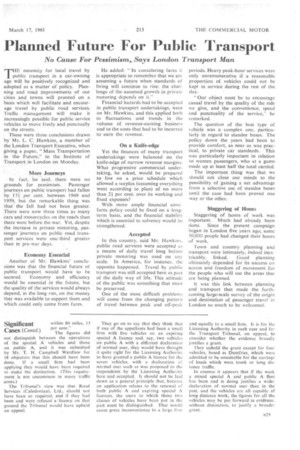Plarmed Future For Public Transport
Page 63

If you've noticed an error in this article please click here to report it so we can fix it.
No Cause For Pessimism,, Says London Transport Man
THE necessity for local travel by public transport in a car-owning age will be positively recognized and adopted as a matter of policy. Planning and road improvements of our cities and towns will proceed on a basis which will facilitate and encourage travel by public road services. Traffic management will make it increasingly possible for public service vehicles to move freely and punctually on the streets.
These were three conclusions drawn by Mr. L. C. Hawkins, a member of ' the London Transport Executive, when. giving a paper, "Mass Transportation in theFuture," to the Institute of Transport-in-London on Monday. • M—ore Journeys in fact, he said, .there were no grounds for pessirnistn. Passenger journeys on public transport had fallen by .1.74 per cent. between 1949 and 1959, but the remarkable thing was that the fall had not been 'greater. There were now three times as many cars and motorcycles, on the roads than there were before the war. Yet, despite the increase in private motoring, passenger journeys on public road transport services were one-third greater than in pre-war days.
Economy Essential Another of Mr. Hawkins' conclusions was that the financial future of public transport would have to be secured. Economy and efficiency would be essential in the future, but the quality of the services would always depend, in the long run, on the money that was available to support them and which could only come from fares. He added: "in considering fares it is appropriate to remember that we are assuming a future when standards of living will continue to rise:. the challenge of the assumed growth private motoring depends on it."
Financial hazards had to be accepted in public transport undertakings, went on Mr. Hawkins, and this applied both to fluctuations --and• trends in the volume of revenue-earning, business and to the costs that-had to be incurred to earn -the revenue.
On a Knife-edge Yet the finances of many transport undertakings were balanced on the knife-edge of narrow revenue margins. What progressivecommercial undertaking, he asked, would be prepared to live on a price schedule which allowed a surplus. {assuming everything went accOrcling to .plan) of no more than 24.per cent, over its working and fixed expenses?
With more ample financial cove fares.policy could be fixed on a longterm basis, and the financial stability which is.essential to solvency would be strengthened.
. Accepted In this country, said Mr.. Hawkins, public road services were accepted as a means of daily travel long before private motoring was used on any scale. In America, for instance, the opposite happened. Travel by public transport was still accepted here as part of the daily way of life. This attitude of the public was something that must be preserved.
One of the most difficult problems will come from the changing pattern of travel between peak and off-peak periods. Heavy peak-hour services were only unremunerative if a reasonable proportion of vehicles could not be kept in service during the rest of the day.
"Our object must be to encourage casual travel by the quality of the ride we give, and the convenience, speed and punctuality of the service," he remarked.
The question of the best type of 'chicle was a complex one, particularly in regard to standee buses. The policy down the years had been to provide comfort, as near as was practical, to private car standards. This was particularly important in relation to women passengers, who at a guess made up at least half the total carried.
The important thing was that we should not close our minds to the possibility of gaining a net advantage from a selective use of standee buses until the case had been proved one way or the other.
Staggering of Hourg Staggering of hours of work was important. Much had already been done. Since the present campaign began in London five years ago, some 50,000 people had changed their hours of work.
Town and country planning and transport were intimately, indeed inextricably, linked. Good planning ultimately depended for its success on access and freedom of movement for the people who will use the areas that are being planned.
It was this link between planning and transport that made the forthcoming large-scale survey of the origin and destination of passenger travel in London so much to be welcomed.




































































































































